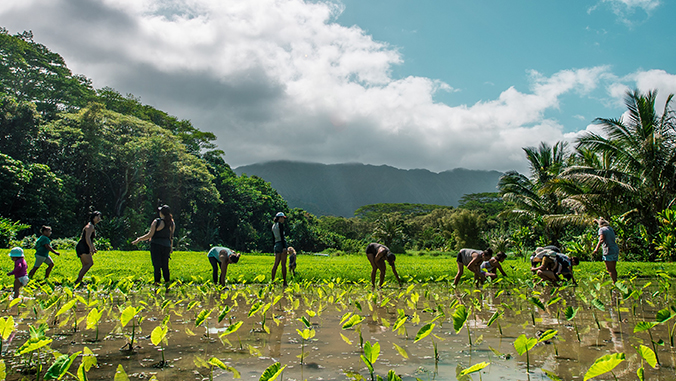
Video and photos courtesy of Kamehameha Schools
Researchers from Kamehameha Schools, University of Hawaiʻi at Mānoa, and the U.S. Geological Survey have published a study in the journal Nature Sustainability (March 2019) highlighting the large role indigenous agriculture can play in producing food, while supporting biodiversity and indigenous well-being in Hawaiʻi under intense land use and climate change.
The researchers focused on the archipelago of Hawaiʻi, where development pressure, rates of food importation and threats to unique native species are among the highest in the world. Furthermore, climate change impacts are expected to increase risks to communities in isolated regions like the Pacific, heightening the necessity of resilient, locally-produced food and community-based solutions.
Past, present and future potential
To determine the past, present and future potential of indigenous Hawaiian agroecosystems and inform their restoration, the researchers developed spatial distribution models of three main Kānaka Maoli (Native Hawaiian) agroecosystems under current and future climate change scenarios. The models incorporate environmental and climatic data to determine areas suitable for certain crops and agricultural systems.
The team found that Hawaiʻi could have sustained approximately 250,000 acres of traditional agroecosystems, potentially producing more than 1 million metric tons of food annually, levels comparable to food consumption in Hawaiʻi today. Furthermore, the study’s carrying capacity estimates lend support to previous hypotheses that pre-contact Kānaka Maoli populations were comparable to Hawaiʻi’s current population.
Natalie Kurashima, lead author of the study and former graduate student in UH Mānoa botany professor Tamara Ticktin’s lab said, “For indigenous communities around the world, the restoration of indigenous food systems goes far beyond food security, providing opportunities for strengthening identity, social ties, knowledge transmission, and well-being, inseparable from indigenous food. All of these characteristics, evident in the growing number of ʻāina revitalization efforts going on across Hawaiʻi, can improve social resilience to climate change.”
Effects of urban development
The study also showed that although Hawaiʻi is one of the most urbanized Pacific Islands, urban development has only slightly reduced potential traditional agroecosystems and the majority of suitable areas (71 percent) remain agriculturally zoned, and thus could be restored without land use restrictions today. However, like many agricultural lands around the globe, these areas are continually threatened by land conversion and development, emphasizing the current need to protect and utilize these indigenous agricultural lands.
The researchers found that projected effects of three future climate scenarios vary from no change in potential production, to decreases of 19 percent in the driest and warmest end-of-century scenario, meaning that large indigenous agricultural areas will likely be viable under a range of future climate changes.
“Our study provides a new understanding of the food production contribution of indigenous Hawaiian agriculture now and into the future, and really highlights the relevance of restoring indigenous agricultural systems today,” said Ticktin who is also co-author on the study. “These systems are flexible and adaptive, and include both traditional and modern crops.”

